Gigabyte GA-X79-UP4 Manual

GA-X79-UP4
User's Manual
Rev. 1001
12ME-X79UP4-1001R

Motherboard
GA-X79-UP4
Jul. 27, 2012
Motherboard
GA-X79-UP4
Jul. 27, 2012
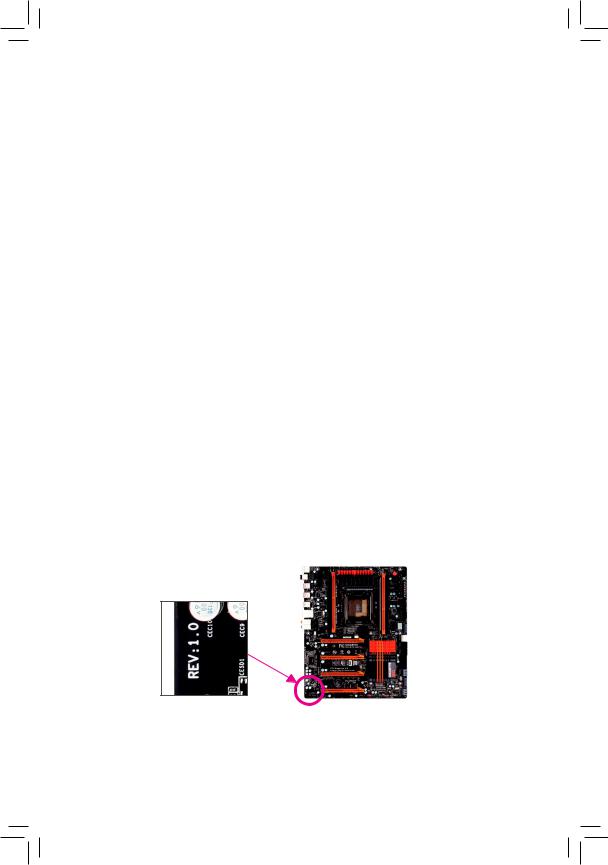
Copyright
© 2012 GIGA-BYTE TECHNOLOGY CO., LTD. All rights reserved.
The trademarks mentioned in this manual are legally registered to their respective owners.
Disclaimer
Information in this manual is protected by copyright laws and is the property of GIGABYTE.
Changes to the specifications and features in this manual may be made by GIGABYTE without prior notice.
No part of this manual may be reproduced, copied, translated, transmitted, or published in any form or by any means without GIGABYTE's prior written permission.
Documentation Classifications
In order to assist in the use of this product, GIGABYTE provides the following types of documentations:
For quick set-up of the product, read the Quick Installation Guide included with the product.For detailed product information, carefully read the User's Manual.
For product-related information, check on our website at: http://www.gigabyte.com
Identifying Your Motherboard Revision
The revision number on your motherboard looks like this: "REV: X.X." For example, "REV: 1.0" means the revision of the motherboard is 1.0. Check your motherboard revision before updating motherboard BIOS, drivers, or when looking for technical information.
Example:

Table of Contents
Box Contents.................................................................................................................... |
|
|
6 |
Optional Items.................................................................................................................. |
|
6 |
|
GA-X79-UP4 Motherboard Layout.................................................................................. |
7 |
||
GA-X79-UP4 Motherboard Block Diagram...................................................................... |
8 |
||
Chapter 1 Hardware Installation...................................................................................... |
9 |
||
1-1 |
Installation Precautions.................................................................................... |
9 |
|
1-2 |
Product Specifications................................................................................... |
10 |
|
1-3 |
Installing the CPU and CPU Cooler............................................................... |
13 |
|
|
1-3-1 |
Installing the CPU................................................................................................... |
13 |
|
1-3-2 Installing the CPU Cooler....................................................................................... |
15 |
|
1-4 |
Installing the Memory..................................................................................... |
16 |
|
|
1-4-1 4 Channel Memory Configuration.......................................................................... |
16 |
|
|
1-4-2 |
Installing a Memory................................................................................................ |
17 |
1-5 |
Installing an Expansion Card......................................................................... |
18 |
|
1-6 |
Setting up AMD CrossFireX™/NVIDIA SLI Configuration............................. |
19 |
|
1-7 |
Back Panel Connectors.................................................................................. |
20 |
|
1-8 |
Internal Connectors........................................................................................ |
22 |
|
Chapter 2 BIOS Setup................................................................................................... |
31 |
||
2-1 |
Startup Screen............................................................................................... |
32 |
|
2-2 |
The Main Menu.............................................................................................. |
33 |
|
2-3 |
M.I.T................................................................................................................ |
35 |
|
2-4 |
System............................................................................................................ |
46 |
|
2-5 |
BIOS Features................................................................................................ |
47 |
|
2-6 |
Peripherals..................................................................................................... |
50 |
|
2-7 |
Power Management....................................................................................... |
53 |
|
2-8 |
Save & Exit..................................................................................................... |
55 |
|
- 4 -

Chapter 3 Drivers Installation........................................................................................ |
57 |
|
3-1 |
Installing Chipset Drivers............................................................................... |
57 |
3-2 |
Application Software...................................................................................... |
58 |
3-3 |
Technical Manuals.......................................................................................... |
58 |
3-4 |
Contact........................................................................................................... |
59 |
3-5 |
System............................................................................................................ |
59 |
3-6 |
Download Center............................................................................................ |
60 |
3-7 |
New Program.................................................................................................. |
60 |
Chapter 4 Unique Features........................................................................................... |
61 |
|
4-1 |
BIOS Update Utilities...................................................................................... |
61 |
|
4-1-1 Updating the BIOS with the Q-Flash Utility........................................................... |
61 |
|
4-1-2 Updating the BIOS with the @BIOS Utility........................................................... |
64 |
4-2 |
EasyTune 6..................................................................................................... |
65 |
4-3 |
Q-Share.......................................................................................................... |
66 |
Chapter 5 Appendix |
....................................................................................................... |
67 |
|
5-1 Configuring SATA Hard Drive(s)..................................................................... |
67 |
||
5 |
-1-1 |
Configuring Intel X79 SATA Controllers ................................................................. |
67 |
5 |
-1-2 ................................................. |
Configuring Marvell 88SE9172 SATA Controllers |
73 |
5 |
-1-3 ............................. |
Installing the SATA RAID/AHCI Driver and Operating System |
79 |
5-2 Configuring ...............................................................Audio Input and Output |
86 |
||
5 |
-2-1 ................................................................. |
Configuring 2/4/5.1/7.1 - Channel Audio |
86 |
5 |
-2-2 ........................................................................................ |
Configuring S/PDIF Out |
88 |
5 |
-2-3 ...................................................................... |
Configuring Microphone Recording |
89 |
5 |
-2-4 ..................................................................................... |
Using the Sound Recorder |
91 |
5-3 |
Troubleshooting.............................................................................................. |
92 |
|
5 |
-3-1 ................................................................................. |
Frequently Asked Questions |
92 |
5 |
-3-2 .................................................................................... |
Troubleshooting Procedure |
93 |
5 |
-3-3 .......................................................................................... |
Regulatory Statements |
95 |
- 5 -

Box Contents
55 GA-X79-UP4 motherboard
55 Motherboard driver disk
55 User's Manual
55 Quick Installation Guide
55 Four SATA 6Gb/s cables
55 I/O Shield
55 One 2-Way SLI bridge connector
55 One 3-Way SLI bridge connector
55 One 4-Way SLI bridge connector
55 One 2-Way CrossFireX bridge connector
The box contents above are for reference only and the actual items shall depend on the product package you obtain. The box contents are subject to change without notice.
Optional Items
2-port USB 2.0 bracket (Part No. 12CR1-1UB030-6*R)eSATA bracket (Part No. 12CF1-3SATPW-4*R)
3.5" Front Panel with 2 USB 3.0/2.0 ports (Part No. 12CR1-FPX582-0*R)COM port cable (Part No. 12CF1-1CM001-3*R)
- 6 -
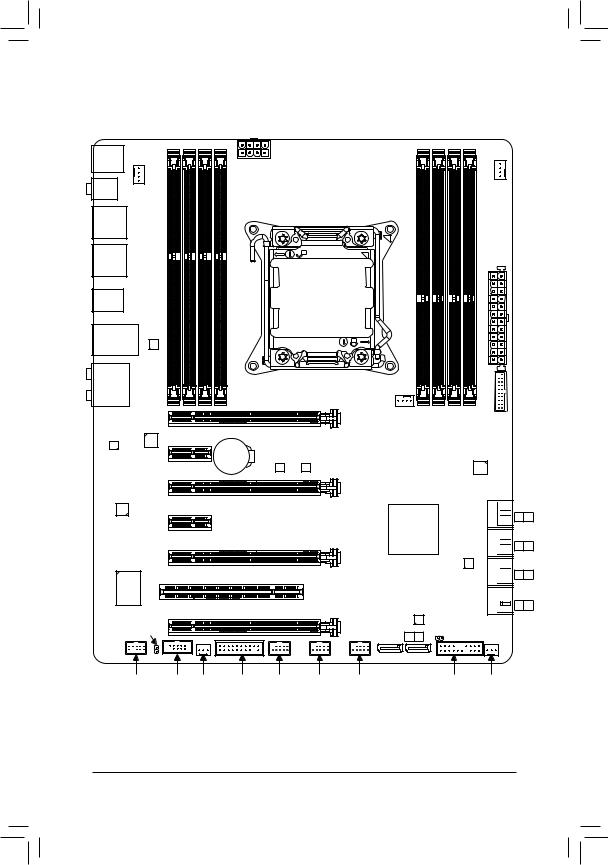
GA-X79-UP4 Motherboard Layout
DDR3_6
DDR3_2
DDR3_8
DDR3_4
KB_MS_USB
R_SPDIF SYS_FAN1
USB_ESATA2
USB_ESATA1
R_USB30
USB_LAN
Marvell 88SE9172
AUDIO
Fresco
FL1009
PCIEX1_1
ATX_12V_2X4
LGA2011
PCIEX16_1
Intel GbE LAN |
BAT |
M_BIOS B_BIOS |
PCIEX8_1
DDR3_3
DDR3_7
DDR3_1
DDR3_5
SYS_FAN2
ATX
CPU_FAN
F_USB30
Fresco
FL1009
CODEC
PCIEX1_2
PCIEX16_2
GA-X79-UP4
Intel® X79
Marvell 88SE9172
 SATA3
SATA3


 10
10


 SATA2
SATA2  32
32
I/O |
PCI |
|
|
|
|
|
iTE Super |
|
|
|
|
Marvell |
|
|
|
|
|
|
|
|
|
PCIEX8_2 |
|
|
|
88SE9172 |
|
|
|
|
|
|
|
|
SPDIF_O |
|
|
GSATA3 |
9 8 |
CLR_CMOS |
|
|
|
|
|
|
||
F_AUDIO |
COMA SYS_FAN4 TPM |
F_USB3 |
F_USB2 |
F_USB1 |
|
F_PANEL |




 SATA2
SATA2 

 54
54


 GSATA3 76
GSATA3 76
SYS_FAN3
- 7 -
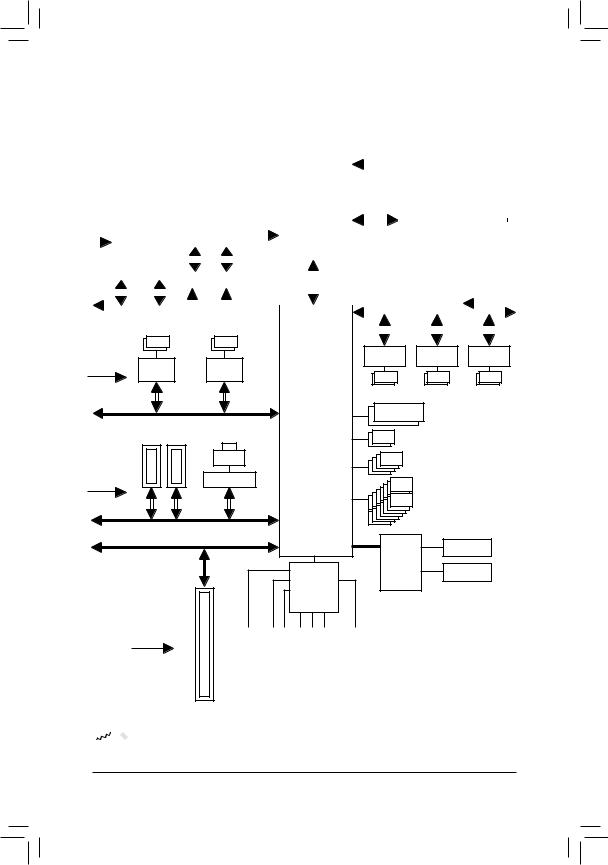
GA-X79-UP4 Motherboard Block Diagram
|
|
|
|
|
1 PCI Express x16 |
2 PCI Express x8 |
|
|
|
|
|
|
|
|
|
|
|
|
|
|
|
|
|
|
|
|
|
|
|
|||||||||||||||||
1 PCI |
|
1 PCI |
|
|
|
|
|
|
|
|
|
|
|
|
|
|
|
CPU CLK+/- (100 MHz) |
|
|
|
|
|
|
|
|
|
|||||||||||||||||||
|
|
|
|
|
|
|
|
|
|
|
|
|
|
|
|
|
|
|
|
|
|
|
|
|
||||||||||||||||||||||
|
|
|
|
|
|
|
|
|
|
|
|
|
|
|
|
|
|
|
|
|
|
|
||||||||||||||||||||||||
PCI Express x16 Express x8 |
|
|
|
|
|
|
|
|
|
|
|
|
|
|
|
|
|
|
|
|
|
|
||||||||||||||||||||||||
|
|
|
|
|
|
|
|
|
|
|
|
|
|
|
|
or |
|
|
|
|
|
|
|
LGA2011 |
|
|
DDR3 2133/1866/1600/1333/1066 MHz |
|||||||||||||||||||
|
|
|
|
|
|
|
|
|
|
|
|
|
|
|
|
|
|
|
|
|
|
|
|
|
||||||||||||||||||||||
|
|
|
|
|
|
|
|
|
|
|
|
|
|
|
|
|
|
|
|
|
|
|
CPU |
|
|
|||||||||||||||||||||
PCIe CLK |
|
|
|
|
|
|
|
|
|
|
|
|
|
|
|
|
|
|
|
|
|
|
|
|
|
|
|
|
|
|
4 Channel Memory |
|
|
|
|
|
|
|||||||||
|
|
|
|
|
|
|
|
|
|
|
|
|
|
|
|
|
|
|
|
|
|
|
|
|
|
|
|
|
|
|
|
|
|
|
|
|
|
|
||||||||
|
|
|
|
|
|
|
|
|
|
|
|
|
|
|
|
|
|
|
|
|
|
|
|
|
|
|
|
|
|
|
|
|
|
|
|
|
|
|
|
|
|
|
|
|
||
|
|
|
|
|
|
|
|
|
|
|
|
|
|
|
|
|
|
|
|
|
|
|
|
|
|
|
|
|
|
|
|
|
|
|
|
|
|
|
|
|
|
|||||
(100 MHz) |
|
|
|
|
|
|
|
|
|
|
|
|
|
|
|
|
|
|
|
|
|
|
|
|
|
|
|
|
|
|
|
|
|
|
|
|
|
|
|
|
|
|
|
|
|
|
|
|
|
|
|
|
|
|
|
|
|
|
|
|
|
|
|
|
|
|
|
|
|
|
|
|
|
|
|
|
|
|
|
|
|
|
|
|
|
|
|
|
|
|
|
|
|
|
|
|
|
|
|
|
|
|
|
|
|
|
|
|
|
x16 |
|
|
x16 |
|
|
|
|
|
|
|
|
|
|
|
|
|
|
|
|
|
|
|
|
|
|
|
|
|
||
|
|
|
|
|
|
DMI 2.0 |
|
|
|
|
|
|
|
|
|
|
|
|
|
|
|
|
|
|
|
|||||||||||||||||||||
|
|
|
|
|
|
|
|
|
|
|
|
|
|
|
|
|
|
|
|
|
|
|
|
|
|
|
|
|
|
|
|
|
|
|
|
|
|
|
|
|
|
|
|
|||
|
|
|
|
|
|
|
|
|
|
|
|
|
|
|
|
Switch |
|
|
|
|
|
|
|
|
|
|
|
|
|
|
|
|
PCIe CLK |
|||||||||||||
|
|
|
x16 |
|
|
|
|
|
|
x8 |
|
|
|
|
|
|
|
|
|
|
|
|
|
|
|
|
|
|
|
|||||||||||||||||
|
|
|
|
|
|
|
|
|
|
|
|
|
|
|
|
|
|
|
|
|
|
|
|
|
PCI Express Bus |
(100 MHz) |
||||||||||||||||||||
|
|
|
|
|
|
|
|
|
|
|
|
|||||||||||||||||||||||||||||||||||
|
|
|
|
|
|
|
|
|
|
|
|
|
|
|
|
|
|
|
|
|
||||||||||||||||||||||||||
|
|
|
|
|
|
|
|
|
|
|
|
|
|
|
|
|
|
|
|
|
|
|
|
|
|
|
|
|
|
|
|
|
|
|
|
|
|
|||||||||
|
|
|
|
|
|
|
PCI Express Bus |
|
|
|
|
|
|
|
|
|
|
|
|
|
|
|||||||||||||||||||||||||
|
|
|
|
|
|
|
|
|
|
|
|
|
|
|
|
|
|
|
|
|
|
|
|
|
|
|
|
|
|
|||||||||||||||||
|
|
|
2 USB 3.0/2.0 2 USB 3.0/2.0 |
|
|
|
|
|
|
|
x1 |
|
|
|
|
x1 |
|
|
x1 |
|||||||||||||||||||||||||||
|
|
|
|
|
|
|
|
|
|
|
|
|
|
|
|
|
|
|
|
|
|
|
|
|
|
|
|
|
|
|
|
|
|
|
|
|
|
|
|
|
|
|
|
|
|
|
PCIe CLK |
|
|
|
|
Marvell |
Marvell |
Marvell |
|
Fresco |
|
Fresco |
|
88SE9172 |
88SE9172 |
88SE9172 |
||
(100 MHz) |
|
|
||||||
|
FL1009 |
|
FL1009 |
|
|
|
|
|
|
x1 |
|
x1 |
|
2 SATA 6Gb/s |
2 SATA 6Gb/s 2 SATA 6Gb/s |
||
|
|
|
|
Dual BIOS |
|
|||
|
PCI Express Bus |
Intel® X79 |
|
|
||||
|
|
|
|
|
|
|||
|
2 PCI Express x1 |
LAN |
|
|
2 SATA 6Gb/s |
|
||
PCIe CLK |
|
|
RJ45 |
|
|
4 SATA 3Gb/s |
|
|
|
|
|
|
|
|
|||
|
|
Intel GbE LAN |
|
|
|
|
|
|
(100 MHz) |
|
|
|
|
|
14 USB 2.0/1.1 |
||
|
x1 |
x1 |
x1 |
|
|
|
||
|
|
|
|
|
|
|||
|
PCI Express Bus |
|
LPC |
|
|
|
||
|
|
|
|
|
|
COM |
||
|
PCI Bus |
|
|
Bus |
iTE |
|||
|
|
|
|
|
||||
|
|
|
|
|
|
Super I/O |
|
|
|
|
|
|
CODEC |
|
|
PS/2 KB/Mouse |
|
|
|
|
|
|
|
|
||
PCI CLK
(33 MHz)
1 PCI
SpeakerSurroundOut Center/Subwoofer SpeakerSide Out |
MIC Line |
S/PDIFOut |
SpeakerOut |
In |
|
Out |
|
|
Line |
|

 For detailed product information/limitation(s), refer to "1-2 Product Specifications."
For detailed product information/limitation(s), refer to "1-2 Product Specifications."
- 8 -

Chapter 1 Hardware Installation
1-1 Installation Precautions
The motherboard contains numerous delicate electronic circuits and components which can become damaged as a result of electrostatic discharge (ESD). Prior to installation, carefully read the user's manual and follow these procedures:
•• Prior to installation, make sure the chassis is suitable for the motherboard.
•• Prior to installation, do not remove or break motherboard S/N (Serial Number) sticker or warranty sticker provided by your dealer. These stickers are required for warranty validation.
•• Always remove the AC power by unplugging the power cord from the power outlet before installing or removing the motherboard or other hardware components.
•• When connecting hardware components to the internal connectors on the motherboard, make sure they are connected tightly and securely.
•• When handling the motherboard, avoid touching any metal leads or connectors.
•• It is best to wear an electrostatic discharge (ESD) wrist strap when handling electronic components such as a motherboard, CPU or memory. If you do not have an ESD wrist strap, keep your hands dry and first touch a metal object to eliminate static electricity.
•• Prior to installing the motherboard, please have it on top of an antistatic pad or within an electrostatic shielding container.
•• Before unplugging the power supply cable from the motherboard, make sure the power supply has been turned off.
•• Before turning on the power, make sure the power supply voltage has been set according to the local voltage standard.
•• Before using the product, please verify that all cables and power connectors of your hardware components are connected.
•• To prevent damage to the motherboard, do not allow screws to come in contact with the motherboard circuit or its components.
•• Make sure there are no leftover screws or metal components placed on the motherboard or within the computer casing.
•• Do not place the computer system on an uneven surface.
•• Do not place the computer system in a high-temperature environment.
•• Turning on the computer power during the installation process can lead to damage to system components as well as physical harm to the user.
•• If you are uncertain about any installation steps or have a problem related to the use of the product, please consult a certified computer technician.
- 9 - |
Hardware Installation |

1-2 |
Product Specifications |
|
|
|
|
|
CPU |
Support for Intel® Core™ i7 processors in the LGA2011 package |
|
|
(Go to GIGABYTE's website for the latest CPU support list.) |
|
|
L3 cache varies with CPU |
|
|
|
|
Chipset |
Intel® X79 Express Chipset |
|
Memory |
8 x 1.5V DDR3 DIMM sockets supporting up to 64 GB of system memory |
* Due to a Windows 32-bit operating system limitation, when more than 4 GB of physical memory is installed, the actual memory size displayed will be less than the size of the physical memory installed.
4 channel memory architecture
Support for DDR3 2133/1866/1600/1333/1066 MHz memory modules
Support for non-ECC memory modules
Support for Extreme Memory Profile (XMP) memory modules
|
|
(Go to GIGABYTE's website for the latest supported memory speeds and |
|
|
memory modules.) |
Audio |
|
Realtek ALC892 codec |
|
High Definition Audio |
|
|
|
2/4/5.1/7.1-channel |
|
Support for S/PDIF Out |
|
|
|
|
LAN |
|
Intel GbE LAN chip (10/100/1000 Mbit) |
|
|
|
Expansion Slots |
|
2 x PCI Express x16 slots, running at x16 (PCIEX16_1, PCIEX16_2) |
* For optimum performance, if only one PCI Express graphics card is to be installed, be sure to install it in the PCIEX16 slot.
2 x PCI Express x16 slots, running at x8 (PCIEX8_1, PCIEX8_2)
* The PCIEX8_2 slot shares bandwidth with the PCIEX16_2 slot. When the
PCIEX8_2 slot is populated, the PCIEX16_2 slot will operate at up to x8 mode.
(All PCI Express x16 slots conform to PCI Express 3.0 standard.)
2 x PCI Express x1 slots
(All PCI Express x1 slots conform to PCI Express 2.0 standard.)
1 x PCI slot
Multi-Graphics |
|
Support for 4-Way/3-Way/2-Way AMD CrossFireX™/NVIDIA SLI technology |
|
Technology |
|
|
|
Storage Interface |
|
Chipset: |
|
|
|
- |
2 x SATA6Gb/s connectors (SATA3 0/1) supporting up to 2 SATA6Gb/s devices |
|
|
- |
4 x SATA3Gb/s connectors (SATA2 2~5)supporting up to 4 SATA3Gb/s devices |
|
|
- |
Support for RAID 0, RAID 1, RAID 5, and RAID 10 |
|
|
|
* When a RAID set is built across the SATA 6Gb/s and SATA 3Gb/s channels, the |
|
|
|
system performance of the RAID set may vary depending on the devices being |
|
|
|
connected. |
|
|
3 x Marvell 88SE9172 chips: |
|
-4 x SATA6Gb/s connectors (SATA3 6~9)supporting up to 4 SATA6Gb/s devices
-2 x eSATA 6Gb/s connectors on the back panel supporting up to 2 SATA 6Gb/s devices
-Support for RAID 0 and RAID 1
Hardware Installation |
- 10 - |

USB |
Chipset: |
|
- Up to 14 USB 2.0/1.1 ports (8 ports on the back panel, 6 ports available |
|
through the internal USB headers) |
2 x Fresco FL1009 chips:
-Up to 4 USB 3.0/2.0 ports (2 ports on the back panel, 2 ports available through the internal USB header)
Internal |
1 x 24-pin ATX main power connector |
|
Connectors |
1 x 8-pin ATX 12V power connector |
|
|
6 x SATA 6Gb/s connectors |
|
|
4 x SATA 3Gb/s connectors |
|
|
1 x CPU fan header |
|
|
4 x system fan headers |
|
|
1 x front panel header |
|
|
1 x front panel audio header |
|
|
1 x S/PDIF Out header |
|
|
1 x USB 3.0/2.0 header |
|
|
3 x USB 2.0/1.1 headers |
|
|
1 x serial port header |
|
|
1 x Clear CMOS jumper |
|
|
1 x Trusted Platform Module (TPM) header |
|
|
|
|
Back Panel |
1 x PS/2 keyboard/mouse port |
|
Connectors |
1 x optical S/PDIF Out connector |
|
|
1 x coaxial S/PDIF Out connector |
|
|
8 x USB 2.0/1.1 ports |
|
|
2 x USB 3.0/2.0 ports |
|
|
2 x eSATA 6Gb/s connectors |
|
|
1 x RJ-45 port |
|
|
6 x audio jacks (Center/Subwoofer Speaker Out/Rear Speaker Out/Side |
|
|
|
Speaker Out/Line In/Line Out/Microphone) |
|
|
|
I/O Controller |
iTE I/O Controller Chip |
|
|
|
|
Hardware |
|
System voltage detection |
Monitor |
|
CPU/System temperature detection |
|
CPU/System fan speed detection |
|
|
CPU overheating warning |
|
|
CPU/System fan fail warning |
|
|
CPU/System fan speed control |
|
*Whether the CPU/system fan speed control function is supported will depend on the CPU/system cooler you install.
- 11 - |
Hardware Installation |
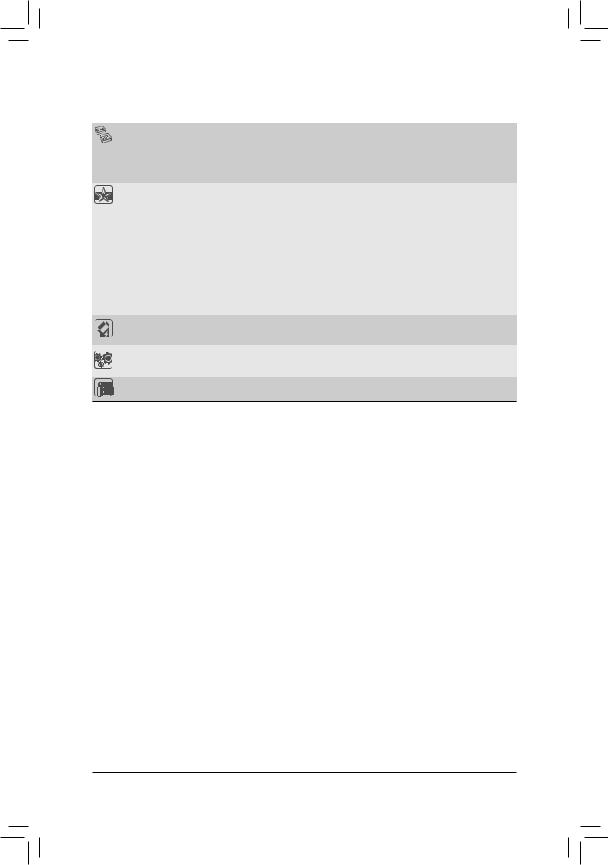
BIOS |
|
2 x 64 Mbit flash |
|
Use of licensed AMI EFI BIOS |
|
|
|
Support for DualBIOS™ |
|
PnP 1.0a, DMI 2.0, SM BIOS 2.6, ACPI 2.0a |
|
|
|
|
Unique Features |
|
Support for @BIOS |
|
|
Support for Q-Flash |
Support for Xpress InstallSupport for EasyTune
|
|
* Available functions in EasyTune may differ by motherboard model. |
|
|
Support for ON/OFF Charge |
||
|
Support for 3TB+ Unlock |
||
|
|
Support for Q-Share |
|
|
Support for 3D Power |
||
|
|
|
|
Bundled |
Norton Internet Security (OEM version) |
||
Software |
|||
|
|
||
|
|
|
|
Operating |
|
Support for Microsoft® Windows 7/Vista/XP |
|
System |
|
|
|
Form Factor |
|
ATX Form Factor; 30.5cm x 24.4cm |
|
*GIGABYTE reserves the right to make any changes to the product specifications and product-related information without prior notice.
*Please visit GIGABYTE's website to check the supported operating system(s) for the software listed in the "Unique
Features" and "Bundled Software" columns.
Hardware Installation |
- 12 - |
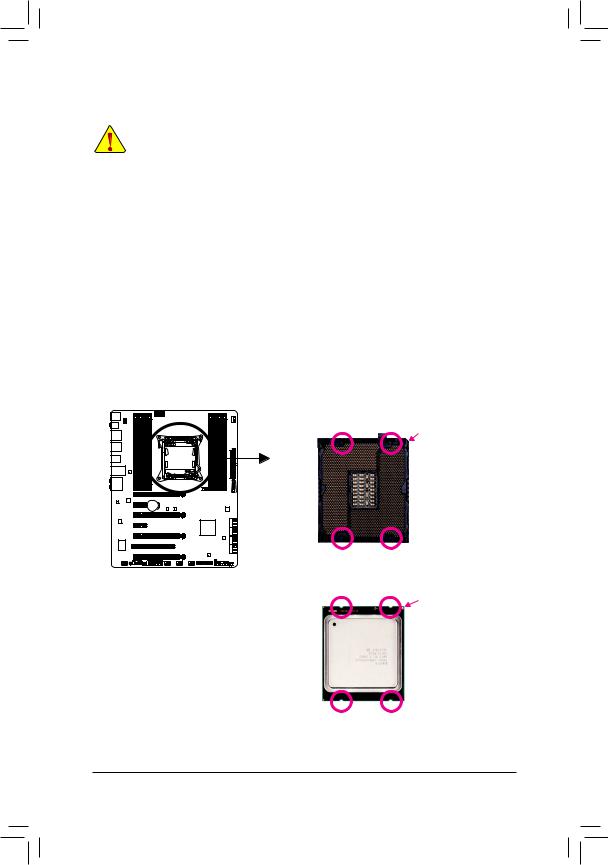
1-3 |
Installing the CPU and CPU Cooler |
|
|
Read the following guidelines before you begin to install the CPU: |
|
|
•• |
Make sure that the motherboard supports the CPU. |
|
|
(Go to GIGABYTE's website for the latest CPU support list.) |
|
•• |
Always turn off the computer and unplug the power cord from the power outlet before installing the |
|
|
CPU to prevent hardware damage. |
|
•• |
Locate the pin one of the CPU. The CPU cannot be inserted if oriented incorrectly. (Or you may |
|
|
locate the notches on both sides of the CPU and alignment keys on the CPU socket.) |
|
•• |
Apply an even and thin layer of thermal grease on the surface of the CPU. |
|
•• |
Do not turn on the computer if the CPU cooler is not installed, otherwise overheating and damage |
|
|
of the CPU may occur. |
|
•• |
Set the CPU host frequency in accordance with the CPU specifications. It is not recommended |
|
|
that the system bus frequency be set beyond hardware specifications since it does not meet the |
|
|
standard requirements for the peripherals. If you wish to set the frequency beyond the standard |
|
|
specifications, please do so according to your hardware specifications including the CPU, graphics |
|
|
card, memory, hard drive, etc. |
1-3-1 Installing the CPU
A. Locate the alignment keys on the motherboard CPU socket and the notches on the CPU.
LGA2011 CPU Socket
Alignment Key |
Alignment Key |
Pin One Corner of the CPU |
|
|
|
|
|
Socket |
Alignment Key Alignment Key
LGA2011 CPU
Notch Notch
Triangle Pin One
Marking on the CPU
Notch Notch
- 13 - |
Hardware Installation |
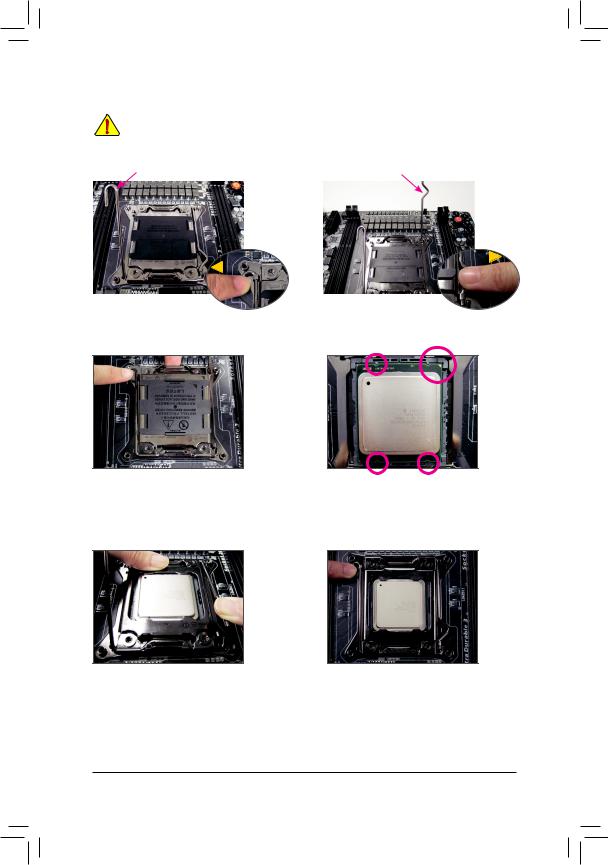
B. Follow the steps below to correctly install the CPU into the motherboard CPU socket.
• Before installing the CPU, make sure to turn off the computer and unplug the power cord from the power outlet to prevent damage to the CPU.
• To protect the socket contacts, do not remove the protective plastic cover unless the CPU is inserted into the CPU socket. Save the cover properly and replace it if the CPU is removed.
Lever A |
|
Lever B |
|
||
|
|
|
|
|
|
|
|
|
|
|
|
|
|
|
|
|
|
|
|
|
|
|
|
|
|
|
|
|
|
|
|
|
|
|
|
Step 1:
Push the lever closest to the "unlock" marking " "
"
(below referred as lever A) down and away from the socket to release it.
Step 3:
Gently press lever A to allow the load plate to rise. Open the load plate. Note: DO NOT touch the socket contacts after the load plate is opened.
Step 5:
Once the CPU is properly inserted, carefully replace the load plate. Then secure lever B under its retention tab. The protective plastic cover may pop off from the load plate during the process of engaging the lever. Remove the cover. Save the cover properly and always replace it when the CPU is not installed.
Hardware Installation |
- 14 - |
Step 2:
Push the lever closest to the "lock" marking " "
"
(below referred as lever B) down and away from the socket. Then lift the lever.
Step 4:
Hold the CPU with your thumb and index fingers. Align the CPU pin one marking (triangle) with the pin one corner of the CPU socket (or align the CPU notches with the socket alignment keys) and carefully insert the CPU into the socket vertically.
Step 6:
Finally, secure lever A under its retention tab to complete the installation of the CPU.
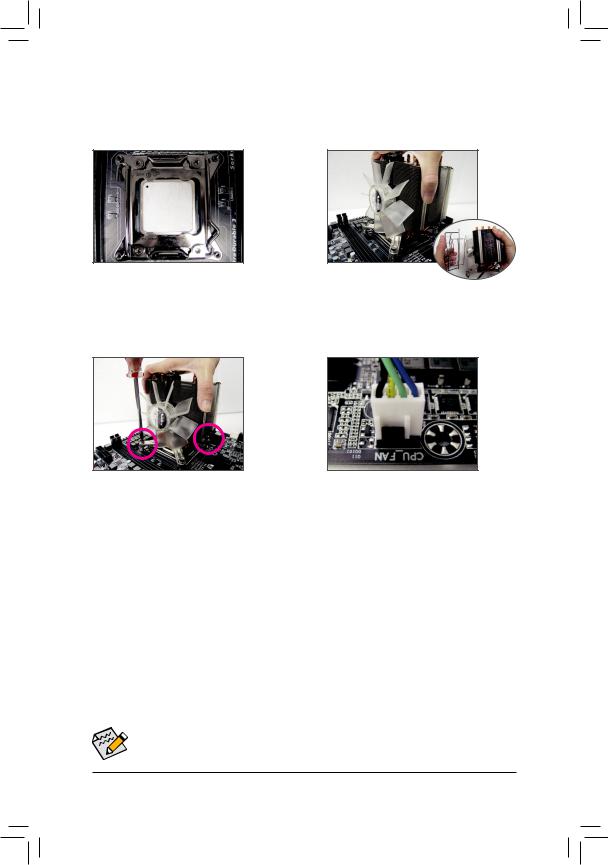
1-3-2 Installing the CPU Cooler
Follow the steps below to correctly install the CPU cooler on the motherboard. (The following procedure uses Intel® boxed cooler as the example cooler.)
Step 1:
Apply an even and thin layer of thermal grease on the surface of the installed CPU.
Step 3:
Use one hand to hold the cooler and the other to tighten the screws in a diagonal sequence with a screw driver. Begin tightening a screw with a few turns and repeat with the screw diagonally opposite the one you just tightened. Then do the same to the other pair. Next, fully tighten the four screws.
Step 2:
Place the cooler atop the CPU, aligning the four mounting screws with the mounting holes on the
ILM.(Ifyourcoolerhasafangrillwhichmaycause interference when you tighten the screws, remove it first and replace it after tightening the screws.)
Step 4:
Finally, attach the power connector of the CPU cooler to the CPU fan header (CPU_FAN) on the motherboard.
 Use extreme care when removing the CPU cooler because the thermal grease/tape between the CPU cooler and CPU may adhere to the CPU. Inadequately removing the CPU cooler may damage the CPU.
Use extreme care when removing the CPU cooler because the thermal grease/tape between the CPU cooler and CPU may adhere to the CPU. Inadequately removing the CPU cooler may damage the CPU.
- 15 - |
Hardware Installation |

1-4 Installing the Memory
Read the following guidelines before you begin to install the memory:
•• Make sure that the motherboard supports the memory. It is recommended that memory of the same capacity, brand, speed, and chips be used.
(Go to GIGABYTE's website for the latest supported memory speeds and memory modules.)
•• Always turn off the computer and unplug the power cord from the power outlet before installing the memory to prevent hardware damage.
•• Memory modules have a foolproof design. A memory module can be installed in only one direction. If you are unable to insert the memory, switch the direction.
1-4-1 4 Channel Memory Configuration
This motherboard provides eight DDR3 memory sockets and supports 4 Channel Technology. After the memory is installed, the BIOS will automatically detect the specifications and capacity of the memory. The eight DDR3 memory sockets are divided into four channels and each channel has two memory sockets as following:
Channel A: DDR3_1, DDR3_5Channel B: DDR3_2, DDR3_6Channel C: DDR3_3, DDR3_7Channel A: DDR3_4, DDR3_8
DDR3 4 DDR3 8 DDR3 2 DDR3 6 |
DDR3 5 DDR3 1 DDR3 7 DDR3 3 |
 4 Channel Memory Configurations Table
4 Channel Memory Configurations Table
|
|
DDR3_4 DDR3_8 |
DDR3_2 DDR3_6 |
DDR3_5 |
DDR3_1 DDR3_7 |
DDR3_3 |
|||
Four Modules |
|
DS/SS |
- - |
DS/SS |
- - |
- - |
DS/SS |
- - |
DS/SS |
Eight Modules |
|
DS/SS |
DS/SS |
DS/SS |
DS/SS |
DS/SS |
DS/SS |
DS/SS |
DS/SS |
 Dual/3 Channel Memory Configurations Table
Dual/3 Channel Memory Configurations Table
|
DDR3_4 DDR3_8 DDR3_2 |
DDR3_6 |
DDR3_5 |
DDR3_1 DDR3_7 |
DDR3_3 |
|||
Two Modules |
- - |
- - |
DS/SS |
- - |
- - |
DS/SS |
- - |
- - |
|
- - |
- - |
- - |
- - |
- - |
DS/SS |
- - |
DS/SS |
|
DS/SS |
- - |
- - |
- - |
- - |
DS/SS |
- - |
- - |
|
- - |
- - |
DS/SS |
- - |
- - |
- - |
- - |
DS/SS |
|
DS/SS |
- - |
DS/SS |
- - |
- - |
- - |
- - |
- - |
|
DS/SS |
- - |
- - |
- - |
- - |
- - |
- - |
DS/SS |
Three Modules |
- - |
- - |
DS/SS |
- - |
- - |
DS/SS |
- - |
DS/SS |
|
DS/SS |
- - |
DS/SS |
- - |
- - |
DS/SS |
- - |
- - |
|
DS/SS |
- - |
|
- - |
- - |
DS/SS |
- - |
DS/SS |
|
DS/SS |
- - |
DS/SS |
- - |
- - |
- - |
- - |
DS/SS |
(SS=Single-Sided, DS=Double-Sided, "- -"=No Memory) |
|
|
|
|
|
|||
Hardware Installation |
|
|
|
- 16 - |
|
|
|
|
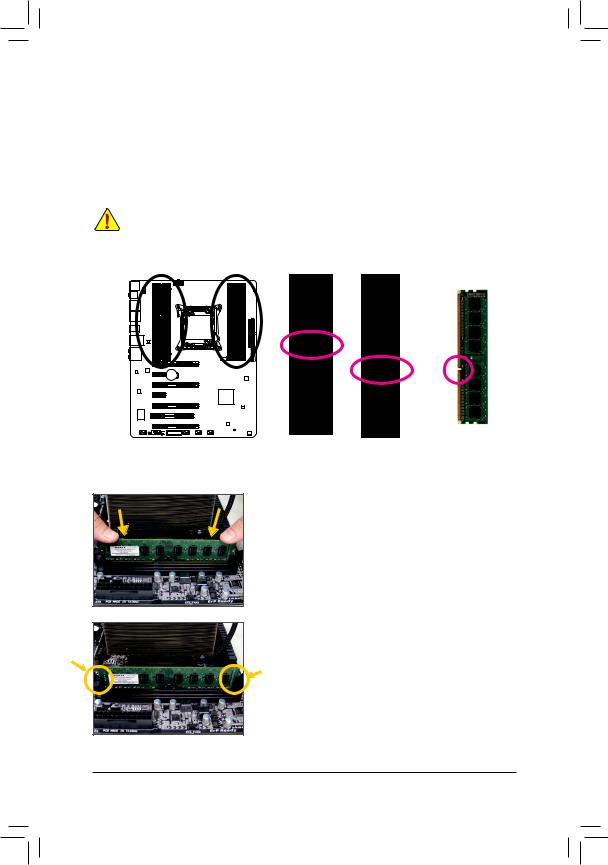
Due to CPU limitations, read the following guidelines before installing the memory in Dual Channel mode.
1.For optimum performance, when enabling Dual Channel mode with two memory modules, we recommend that you install them in the DDR3_1 and DDR3_2 sockets.
2.Wheninstallingthememory,makesuretobeginwiththefirstsocketofeachchannel,suchasDDR3_1,
DDR3_2, DDR3_3, and DDR3_4.
1-4-2 Installing a Memory
Before installing a memory module, make sure to turn off the computer and unplug the power cord from the power outlet to prevent damage to the memory module.
DDR3 and DDR2 DIMMs are not compatible to each other or DDR DIMMs. Be sure to install DDR3 DIMMs on this motherboard.
Notch
DDR3 DIMM
ADDR3 memory module has a notch, so it can only fit in one direction. Follow the steps below to correctly install your memory modules in the memory sockets.
Step 1:
Note the orientation of the memory module. Spread the retaining clips at both ends of the memory socket. Place the memory module on the socket. As indicated in the picture on the left, place your fingers on the top edge of the memory, push down on the memory and insert it vertically into the memory socket.
Step 2:
The clips at both ends of the socket will snap into place when the memory module is securely inserted.
- 17 - |
Hardware Installation |
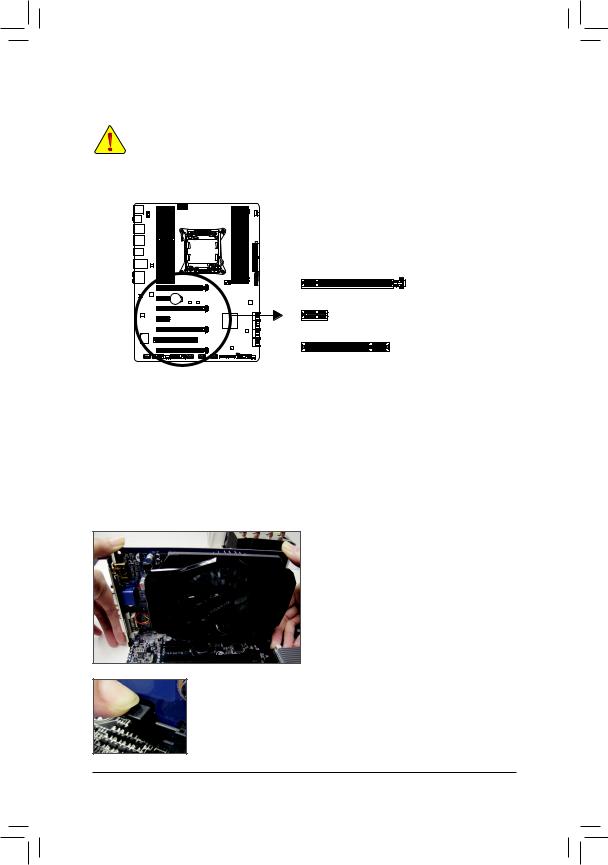
1-5 Installing an Expansion Card
Read the following guidelines before you begin to install an expansion card:
•• Make sure the motherboard supports the expansion card. Carefully read the manual that came with your expansion card.
•• Always turn off the computer and unplug the power cord from the power outlet before installing an expansion card to prevent hardware damage.
PCI Express x16 Slot
PCI Express x1 Slot
PCI Slot
Follow the steps below to correctly install your expansion card in the expansion slot.
1.Locate an expansion slot that supports your card. Remove the metal slot cover from the chassis back panel.
2.Align the card with the slot, and press down on the card until it is fully seated in the slot.
3.Make sure the metal contacts on the card are completely inserted into the slot.
4.Secure the card's metal bracket to the chassis back panel with a screw.
5.After installing all expansion cards, replace the chassis cover(s).
6.Turn on your computer. If necessary, go to BIOS Setup to make any required BIOS changes for your expansion card(s).
7.Install the driver provided with the expansion card in your operating system.
Example: Installing and Removing a PCI Express Graphics Card:
•• Installing a Graphics Card:
Gently push down on the top edge of the card until it is fully inserted into the PCI Express slot. Make sure the card is securely seated in the slot and does not rock.
•• Removing the Card:
Gently push back on the lever on the slot and then lift the card straight out from the slot.
Hardware Installation |
- 18 - |
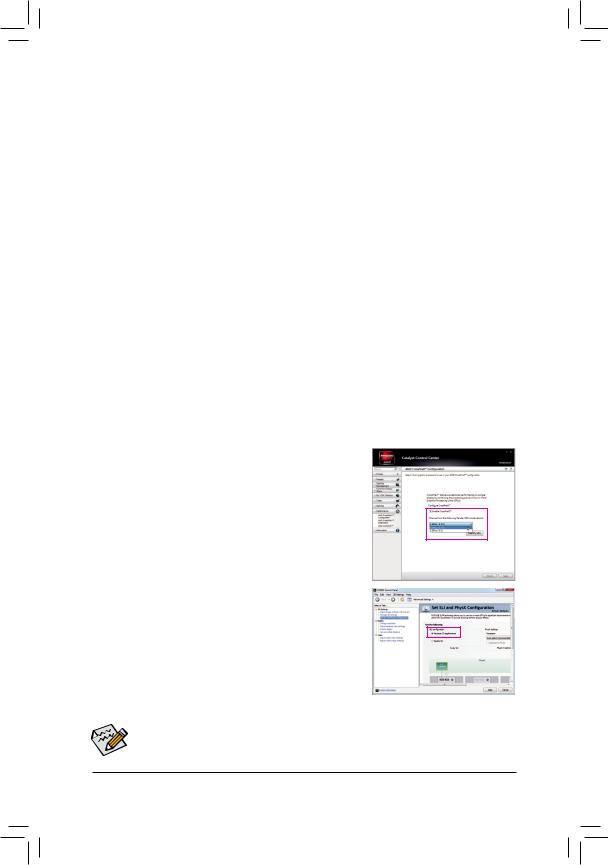
1-6 Setting up AMD CrossFireX™/NVIDIA SLI Configuration
A. System Requirements
-- The 2-Way CrossFireX and 2-Way SLI technologies currently support Windows 7, Vista, XP operating systems -- The 3-Way/4-Way CrossFireX/SLI technologies currently support Windows 7 and Vista operating systems
-- A CrossFireX/SLI-supported motherboard with two/three/four PCI Express x16 slots and correct driver -- Two/three/four CrossFireX/SLI-ready graphics cards of identical brand and chip and correct driver
(Current GPUs that support 3-Way/4-Way CrossFireX technology include the ATI Radeon HD 3800, HD 4800, HD 5800 series, and AMD Radeon HD 6800 and HD 6900 series. Current GPUs that support 3-Way/4-Way SLI technology include the NVIDIA 8800 GTX, 8800 Ultra, 9800 GTX, GTX 260, GTX 280, GTX 470, GTX 480, GTX 570, GTX 580, and GTX
590 series.)
-- CrossFireX(Note)/SLI bridge connectors
-- A power supply with sufficient power is recommended (Note 2) (Refer to the manual of your graphics cards for the power requirement)
B. Connecting the Graphics Cards
Step 1:
Observe the steps in "1-5 Installing an Expansion Card" and install CrossFireX/SLI graphics cards on the PCI Express x16 slots. (To set up a 2-Way configuration, we recommend installing the graphics cards on the PCIEX16_1 and PCIEX16_2 slots.)
Step 2:
Insert the CrossFireX (Note)/SLI bridge connectors in the CrossFireX/SLI gold edge connectors on top of the cards.
Step 3:
Plug the display cable into the graphics card on the PCIEX16_1 slot.
C. Configuring the Graphics Card Driver
C-1. To Enable CrossFireX Function
After installing the graphics card driver in the operating system, go to the Catalyst Control Center. Browse to Performance\AMD CrossFireX™ Configuration and ensure the Enable CrossFireX™ check box is selected. Select the GPU combination you want to use and click
Apply. (Available combination options are dependent on the number of graphics cards.)
C-2. To Enable SLI Function
After installing the graphics card driver in the operating system, go to the NVIDIA Control Panel. Browse to the Set SLI and Physx Configuration screen and ensure Maximize 3D performance is enabled.
(Note) The bridge connector(s) may be needed or not depending on your graphics cards.
Procedure and driver screen for enabling CrossFireX/SLI technology may differ by graphics cards. Refer to the manual that came with your graphics cards for more information about enabling CrossFireX/SLI technology.
- 19 - |
Hardware Installation |
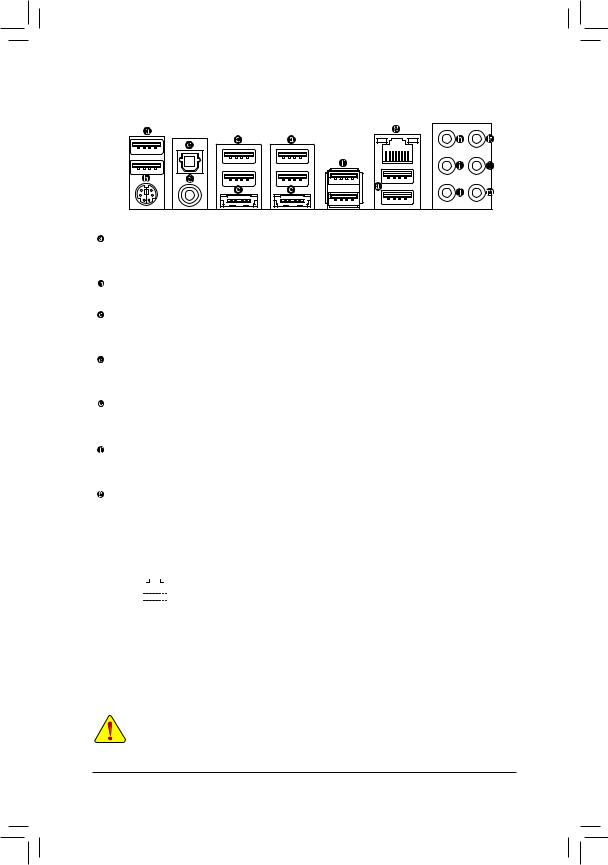
1-7 Back Panel Connectors
USB 2.0/1.1 Port
The USB port supports the USB 2.0/1.1 specification. Use this port for USB devices such as a USB keyboard/mouse, USB printer, USB flash drive and etc.
PS/2 Keyboard/Mouse Port
Use this port to connect a PS/2 mouse or keyboard.
Optical S/PDIF Out Connector
This connector provides digital audio out to an external audio system that supports digital optical audio. Before using this feature, ensure that your audio system provides an optical digital audio in connector.
Coaxial S/PDIF Out Connector
This connector provides digital audio out to an external audio system that supports digital coaxial audio. Before using this feature, ensure that your audio system provides a coaxial digital audio in connector.
eSATA 6Gb/s Connector
This connector supports SATA 6Gb/s specification. Use the port to connect an external SATA device or a SATA port multiplier.
USB 3.0/2.0 Port
The USB 3.0 port supports the USB 3.0 specification and is compatible to the USB 2.0/1.1 specification. Use this port for USB devices such as a USB keyboard/mouse, USB printer, USB flash drive and etc.
RJ-45 LAN Port
The Gigabit Ethernet LAN port provides Internet connection at up to 1 Gbps data rate. The following describes the states of the LAN port LEDs.
Connection/ |
|
|
|
|
|
|
|
|
Connection/Speed LED: |
|
Activity LED: |
|
|||||||
Speed LED |
|
|
|
Activity LED |
|
|
|||||||||||||
|
|
|
|
|
|
|
|
||||||||||||
|
|
|
|
|
|
|
|
|
|
|
|
|
|
|
State |
Description |
|
State |
Description |
|
|
|
|
|
|
|
|
|
|
|
|
|
|
|
Orange |
1 Gbps data rate |
|
Blinking |
Data transmission or receiving is occurring |
|
|
|
|
|
|
|
|
|
|
|
|
|
|
|
Green |
100 Mbps data rate |
|
Off |
No data transmission or receiving is occurring |
|
|
|
|
|
|
|
|
|
|
|
|
|
|
|
|||||
|
|
|
|
|
|
|
|
|
|
|
|
|
|
|
Off |
10 Mbps data rate |
|
|
|
|
|
|
|
|
|
|
|
|
|
|
|
|
|
|
|
|
|
||
|
|
|
|
LAN Port |
|
|
|
||||||||||||
|
|
|
|
|
|
|
|
|
|||||||||||
•• When removing the cable connected to a back panel connector, first remove the cable from your device and then remove it from the motherboard.
•• When removing the cable, pull it straight out from the connector. Do not rock it side to side to prevent an electrical short inside the cable connector.
Hardware Installation |
- 20 - |

Center/Subwoofer Speaker Out Jack (Orange)
Use this audio jack to connect center/subwoofer speakers in a 5.1/7.1-channel audio configuration.
Rear Speaker Out Jack (Black)
This jack can be used to connect front speakers in a 4/5.1/7.1-channel audio configuration.
Side Speaker Out Jack (Gray)
Use this audio jack to connect side speakers in a 7.1-channel audio configuration.
Line In Jack (Blue)
The line out jack. Use this audio jack for line in devices such as an optical drive, walkman, etc.
Line Out Jack (Green)
The line out jack. Use this audio jack for a headphone or 2-channel speaker. This jack can be used to connect front speakers in a 4/5.1/7.1-channel audio configuration.
Mic In Jack (Pink)
The default Mic in jack. Microphones must be connected to this jack.

 In addition to the default speakers settings, the
In addition to the default speakers settings, the ~
~ audio jacks can be reconfigured to perform
audio jacks can be reconfigured to perform
different functions via the audio software. Only microphones still MUST be connected to the default
Mic in jack ( ). Refer to the instructions on setting up a 2/4/5.1/7.1-channel audio configuration in Chapter 5, "Configuring 2/4/5.1/7.1-Channel Audio."
). Refer to the instructions on setting up a 2/4/5.1/7.1-channel audio configuration in Chapter 5, "Configuring 2/4/5.1/7.1-Channel Audio."
- 21 - |
Hardware Installation |
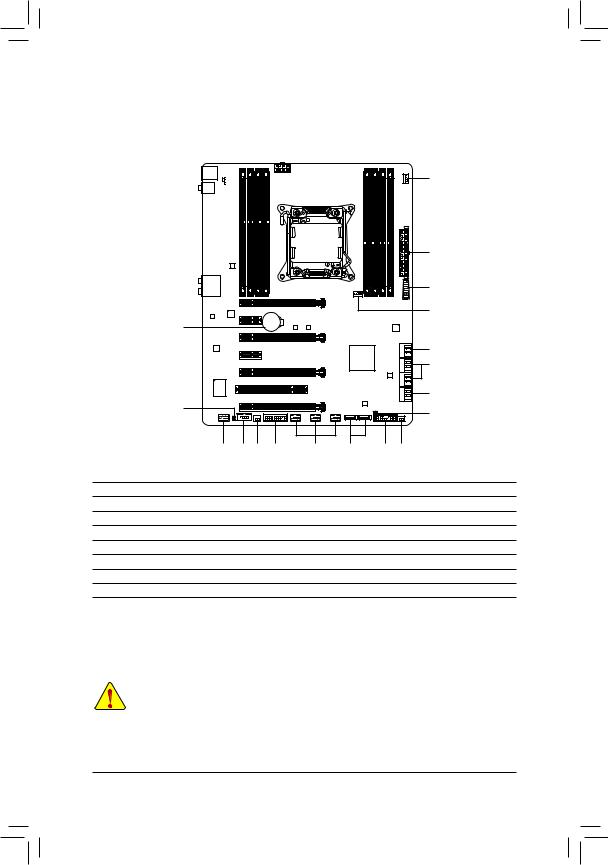
1-8 Internal Connectors
|
|
4 |
1 |
|
|
|
|
|
|
|
|
|
|
|
|
|
|
|
|
|
|
|
|
|
|
|
|
|
|
|
|
|
|
|
|
|
|
|
|
|
|
|
|
|
|
|
|
9
12
11 |
15 |
4 |
16 |
14 |
8 |
10 |
4 |
4
2
13
3
6
7
8
5
1) |
ATX_12V_2X4 |
9) |
BAT |
2) |
ATX |
10) |
F_PANEL |
3) |
CPU_FAN |
11) |
F_AUDIO |
4) |
SYS_FAN1/2/3/4 |
12) |
SPDIF_O |
5) |
CLR_CMOS |
13) |
F_USB30 |
6) |
SATA3 0/1 |
14) |
F_USB1/F_USB2/F_USB3 |
7) |
SATA2 2/3/4/5 |
15) |
COMA |
8) |
GSATA3 6/7/8/9 |
16) |
TPM |
Read the following guidelines before connecting external devices:
•• First make sure your devices are compliant with the connectors you wish to connect.
•• Before installing the devices, be sure to turn off the devices and your computer. Unplug the power cord from the power outlet to prevent damage to the devices.
•• After installing the device and before turning on the computer, make sure the device cable has been securely attached to the connector on the motherboard.
Hardware Installation |
- 22 - |
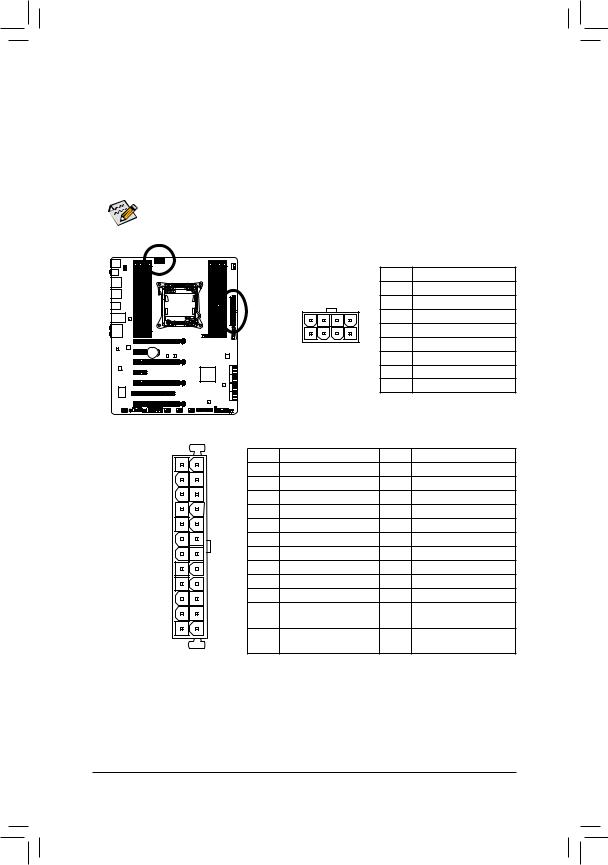
1/2) ATX_12V_2X4/ATX (2x4 12V Power Connector and 2x12 Main Power Connector)
With the use of the power connector, the power supply can supply enough stable power to all the components on the motherboard. Before connecting the power connector, first make sure the power supply is turned off and all devices are properly installed. The power connector possesses a foolproof design. Connect the power supply cable to the power connector in the correct orientation.
The 12V power connector mainly supplies power to the CPU. If the 12V power connector is not connected, the computer will not start.
To meet expansion requirements, it is recommended that a power supply that can withstand high power consumption be used (500W or greater). If a power supply is used that does not provide the required power, the result can lead to an unstable or unbootable system.
12 24
1 |
13 |
ATX
|
|
|
ATX_12V_2X4: |
|
|
|
|
Pin No. |
Definition |
|
|
|
1 |
GND (Only for 2x4-pin 12V) |
|
5 |
8 |
2 |
GND (Only for 2x4-pin 12V) |
|
3 |
GND |
||
|
|
|
||
|
|
|
4 |
GND |
|
1 |
4 |
5 |
+12V (Only for 2x4-pin 12V) |
|
ATX_12V_2X4 |
6 |
+12V (Only for 2x4-pin 12V) |
|
|
|
|
7 |
+12V |
|
|
|
8 |
+12V |
ATX: |
|
|
|
|
Pin No. |
Definition |
|
Pin No. |
Definition |
1 |
3.3V |
|
13 |
3.3V |
2 |
3.3V |
|
14 |
-12V |
3 |
GND |
|
15 |
GND |
4 |
+5V |
|
16 |
PS_ON (soft On/Off) |
5 |
GND |
|
17 |
GND |
6 |
+5V |
|
18 |
GND |
7 |
GND |
|
19 |
GND |
8 |
Power Good |
|
20 |
-5V |
9 |
5VSB (stand by +5V) |
21 |
+5V |
|
10 |
+12V |
|
22 |
+5V |
11 |
+12V (Only for 2x12-pin |
23 |
+5V (Only for 2x12-pin ATX) |
|
|
ATX) |
|
|
|
12 |
3.3V (Only for 2x12-pin |
24 |
GND (Only for 2x12-pinATX) |
|
|
ATX) |
|
|
|
- 23 - |
Hardware Installation |
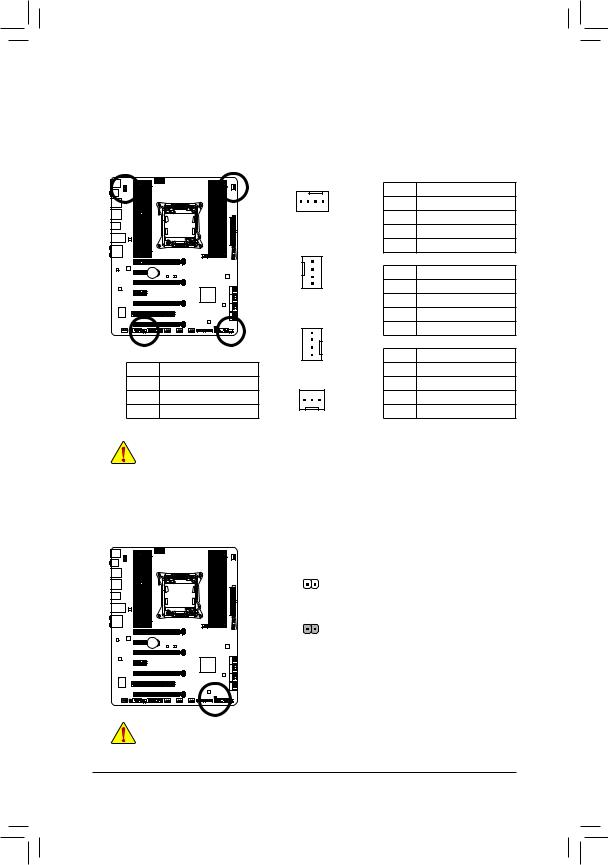
3/4) CPU_FAN/SYS_FAN1/SYS_FAN2/SYS_FAN3/SYS_FAN4 (Fan Headers)
The motherboard has a 4-pin CPU fan header (CPU_FAN), two 4-pin (SYS_FAN1/SYS_FAN2) and two 3-pin(SYS_FAN3/SYS_FAN4) systemfanheaders.Mostfanheaderspossessafoolproofinsertiondesign. When connecting a fan cable, be sure to connect it in the correct orientation (the black connector wire is the ground wire). The speed control function requires the use of a fan with fan speed control design. For optimum heat dissipation, it is recommended that a system fan be installed inside the chassis.
|
|
|
CPU_FAN: |
|
|
|
|
|
Pin No. |
Definition |
|
|
|
1 |
1 |
GND |
|
|
|
CPU_FAN |
2 |
+12V /Speed Control |
|
|
|
|
3 |
Sense |
|
|
|
1 |
4 |
Speed Control |
|
|
|
SYS_FAN1: |
|
||
|
|
|
|
||
|
|
|
Pin No. |
Definition |
|
|
|
SYS_FAN1 |
1 |
GND |
|
|
|
2 |
+12V /Speed Control |
||
|
|
|
|||
|
|
|
3 |
Sense |
|
|
|
|
4 |
Reserve |
|
|
|
|
SYS_FAN2: |
|
|
SYS_FAN3/SYS_FAN4: |
1 |
Pin No. |
Definition |
||
Pin No. |
Definition |
SYS_FAN2 |
1 |
GND |
|
1 |
GND |
|
2 |
+12V |
|
2 |
+12V |
1 |
3 |
Sense |
|
3 |
Sense |
4 |
Speed Control |
||
SYS_FAN3/SYS_FAN4 |
|||||
|
|
|
|
||
•• Be sure to connect fan cables to the fan headers to prevent your CPU and system from overheating. Overheating may result in damage to the CPU or the system may hang.
•• These fan headers are not configuration jumper blocks. Do not place a jumper cap on the headers.
5)CLR_CMOS (Clear CMOS Jumper)
Use this jumper to clear the CMOS values (e.g. date information and BIOS configurations) and reset the
CMOS values to factory defaults. To clear the CMOS values, use a metal object like a screwdriver to touch the two pins for a few seconds.
Open: Normal
Short: Clear CMOS Values
•• Always turn off your computer and unplug the power cord from the power outlet before clearing the CMOS values.
•• After system restart, go to BIOS Setup to load factory defaults (select Load Optimized Defaults) or manually configure the BIOS settings (refer to Chapter 2, "BIOS Setup," for BIOS configurations).
Hardware Installation |
- 24 - |
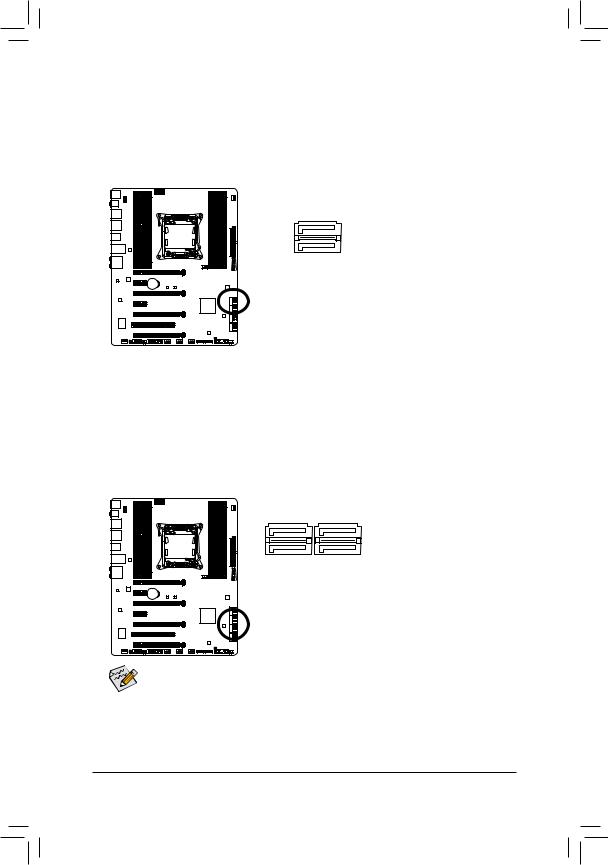
6)SATA3 0/1 (SATA 6Gb/s Connectors, Controlled by Intel X79 Chipset)
The SATA connectors conform to SATA 6Gb/s standard and are compatible with SATA 3Gb/s and SATA 1.5Gb/s standard. Each SATA connector supports a single SATA device. The SATA3 0/1 connectors support RAID 0 and RAID 1. RAID 5 and RAID 10 can be implemented on the two connectors with the SATA2 2/3/4/5 connector (Note).Refer toChapter 5, "Configuring SATAHard Drive(s)," for instructions on configuring a RAID array.
|
|
|
|
Pin No. |
Definition |
SATA3 |
|
1 |
GND |
||
7 |
|
|
1 |
2 |
TXP |
7 |
|
|
1 |
3 |
TXN |
|
|
4 |
GND |
||
|
|
|
|
||
|
1 |
|
|
|
|
|
5 |
RXN |
|||
|
0 |
|
|
||
|
|
|
6 |
RXP |
|
|
|
|
|
||
|
|
|
|
7 |
GND |
7)SATA2 2/3/4/5 (SATA 3Gb/s Connectors, Controlled by Intel X79 Chipset)
The SATA connectors conform to SATA 3Gb/s standard and are compatible with SATA 1.5Gb/s standard. Each SATA connector supports a single SATA device. The Intel Z77 Chipset supports RAID 0, RAID 1,
RAID 5, and RAID 10. Refer to Chapter 5, "Configuring SATAHard Drive(s)," for instructions on configuring a RAID array.
SATA2 |
|
Pin No. |
Definition |
||
7 |
|
|
1 |
1 |
GND |
|
|
2 |
TXP |
||
|
|
|
|
||
7 |
|
|
1 |
3 |
TXN |
|
|
|
|
4 |
GND |
|
5 |
3 |
|
||
|
4 |
2 |
|
5 |
RXN |
|
|
|
|
|
|
|
|
|
|
6 |
RXP |
|
|
|
|
7 |
GND |
•• ARAID 0 or RAID 1 configuration requires at least two hard drives. If more than two hard drives are to be used, the total number of hard drives must be an even number.
•• ARAID 5 configuration requires at least three hard drives. (The total number of hard drives does not have to be an even number.)
•• A RAID 10 configuration requires four hard drives.
(Note) When a RAID set is built across the SATA6Gb/s and SATA3Gb/s channels, the system performance of the RAID set may vary depending on the devices being connected.
- 25 - |
Hardware Installation |
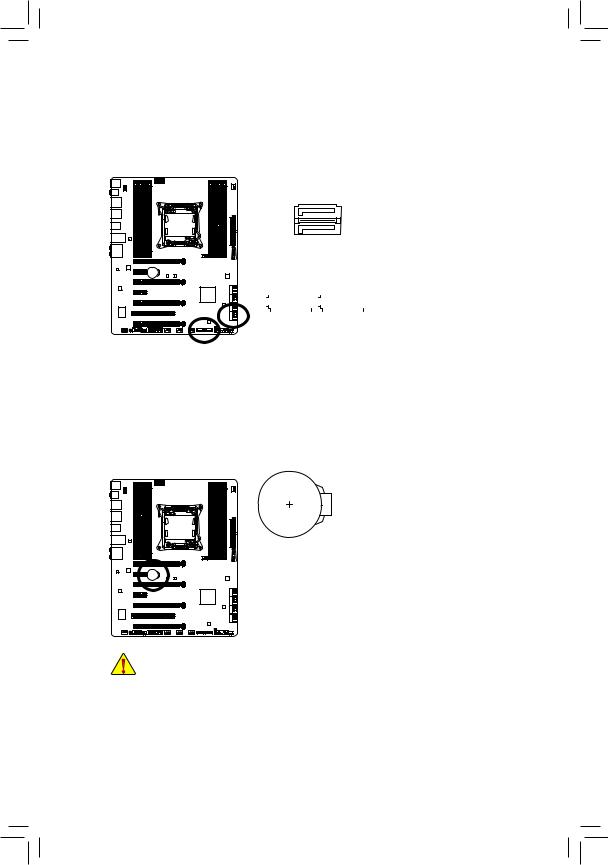
8)GSATA3 6/7/8/9 (SATA 6Gb/s Connectors, Controlled by Marvell 88SE9172 Chip)
The SATA connectors conform to SATA 6Gb/s standard and are compatible with SATA 3Gb/s and SATA 1.5Gb/s standard. Each SATA connector supports a single SATA device. The Marvell 88SE9172 chip supports RAID 0 and RAID 1. Refer to Chapter 5, "Configuring SATA Hard Drive(s)," for instructions on configuring a RAID array.
|
|
|
|
|
GSATA3 |
|
|
|
|
|
Pin No. |
Definition |
|||||||
7 |
1 |
|
|
|
|
1 |
GND |
||||||||||||
|
|
|
|
|
|
|
|
|
|
|
|
||||||||
|
|
|
|
|
|
|
|
|
|
|
|
2 |
TXP |
||||||
7 |
|
|
|
|
|
|
|
|
1 |
|
|
|
|
||||||
|
|
|
|
|
|
|
|
|
|
|
|
3 |
TXN |
||||||
|
|
|
|
|
|
|
|
|
|
|
|
|
|
|
|
|
|
||
|
|
|
|
|
|
|
|
|
|
|
|
|
|
|
|
|
|
4 |
GND |
|
|
|
|
|
|
|
|
7 |
|
|
|
|
|
|
|
|
|
||
|
|
|
|
|
|
|
|
6 |
|
|
|
|
|
|
|
|
|
5 |
RXN |
|
|
|
|
|
|
|
|
|
|
|
|
|
|
|
|
|
|
|
|
|
|
|
|
|
GSATA3 |
|
|
|
|
|
6 |
RXP |
|||||||
|
|
|
|
|
|
|
|
|
|
7 |
GND |
||||||||
1 |
|
|
|
|
|
|
|
|
|
|
|
|
|
|
|
|
7 |
|
|
|
|
|
|
|
|
|
|
|
|
|
|
|
|
|
|
|
|||
|
|
|
|
|
|
|
|
|
|
|
|
|
|
|
|
|
|
|
|
|
|
|
|
|
9 |
8 |
|
|
|
|
|
|
|
|
|
||||

 A RAID 0 or RAID 1 configuration requires two hard drives.
A RAID 0 or RAID 1 configuration requires two hard drives.
9)BAT (Battery)
The battery provides power to keep the values (such as BIOS configurations, date, and time information) in the CMOS when the computer is turned off. Replace the battery when the battery voltage drops to a low level, or the CMOS values may not be accurate or may be lost.
You may clear the CMOS values by removing the battery: 1. Turn off your computer and unplug the power cord.
2. Gently remove the battery from the battery holder and wait for one minute.
(Or use a metal object like a screwdriverto touch the positive and negative terminals of the battery holder, making them short for 5 seconds.)
3. Replace the battery.
4. Plug in the power cord and restart your computer.
•• Always turn off your computer and unplug the power cord before replacing the battery.
•• Replace the battery with an equivalent one. Danger of explosion if the battery is replaced with
|
an incorrect model. |
|
•• Contact the place of purchase or local dealer if you are not able to replace the battery by yourself |
||
|
or uncertain about the battery model. |
|
•• |
When installing the battery, note the orientation of the positive side (+) and the negative side (-) |
|
|
of the battery (the positive side should face up). |
|
•• |
Used batteries must be handled in accordance with local environmental regulations. |
|
|
|
|
Hardware Installation |
- 26 - |
|
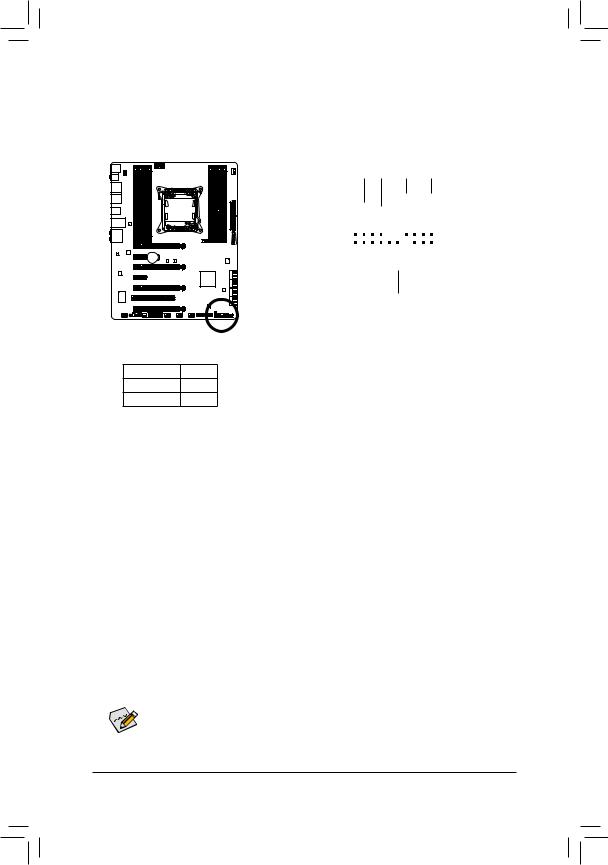
10)F_PANEL (Front Panel Header)
Connect the power switch, reset switch, speaker, chassis intrusion switch/sensor and system status indicator on the chassis to this header according to the pin assignments below. Note the positive and negative pins before connecting the cables.
Message/Power/ |
|
Power |
|
|
|
|
|
|
|
|
|
|||||||||||
|
Sleep LED |
|
Switch |
|
|
|
Speaker |
|
||||||||||||||
|
|
|
|
|
|
|
|
|
|
|
|
|
|
|
|
|
|
|
|
|
|
|
|
|
|
|
|
|
|
|
|
|
|
|
|
|
|
|
|
|
|
||||
|
|
MSG+ MSG |
|
-PW |
|
|
SPEAK+ |
-SPEAK |
||||||||||||||
|
|
|
|
|
||||||||||||||||||
2 |
|
- PW+ |
|
|
|
|
|
|
|
|
|
|
|
|
|
|
20 |
|||||
|
|
|
|
|
|
|
|
|
|
|
|
|
|
|
|
|
|
|
|
|||
|
|
|
|
|
|
|
|
|
|
|
|
|
|
|
|
|
|
|
|
|||
|
|
|
|
|
|
|
|
|
|
|
|
|
|
|
|
|
|
|
|
|||
|
|
|
|
|
|
|
|
|
|
|
|
|
|
|
|
|
|
|
|
|||
1 |
|
|
|
|
|
|
|
|
|
|
|
|
|
|
|
|
|
|
|
|
19 |
|
|
|
|
|
|
|
|
|
|
|
|
|
|
|
|
|
|
|
|
|
|||
|
|
|
|
|
|
|
|
|
|
|
|
|
|
|
|
|
|
|
|
|
|
|
|
|
|
HD- |
|
RES+ |
|
CI+ |
PWR+ |
PWR- |
|||||||||||||
|
|
HD+ |
|
|
RES- |
|
||||||||||||||||
|
|
|
|
|
CI |
|||||||||||||||||
|
|
|
|
|
|
|
|
- |
|
|
|
|
|
|
|
|
|
|||||
|
|
|
|
|
|
|
|
|
|
|
|
|
|
|
|
|
|
|
|
|
||
|
|
|
|
|
|
|
|
|
|
|
|
|
|
|
|
|
|
|
|
|
|
|
|
|
|
|
|
|
|
|
|
|
|
|
|
|
|
|
|
|
|
|
|
|
|
|
|
|
|
|
|
|
|
|
|
|
|
|
|
|
|
|
|
|
|
|
||
|
Hard Drive |
|
|
|
Reset |
|
|
|
Power LED |
|
||||||||||||
|
Activity LED |
|
|
|
Switch |
|
|
|
|
|
|
|
|
|
|
|
||||||
|
|
|
|
|
|
|
|
|
|
|
|
|
|
Chassis Intrusion |
|
|||||||
|
|
|
|
|
|
|
|
|
|
|
|
|
|
Header |
|
|
|
|||||
•• MSG/PWR (Message/Power/Sleep LED, Yellow/Purple):
System Status |
LED |
S0 |
On |
S3/S4/S5 |
Off |
Connects to the power status indicator on the chassis front panel. The LED is on when the system is operating. The LED is off when the system is in S3/
S4 sleep state or powered off (S5).
•• PW (Power Switch, Red):
Connects to the power switch on the chassis front panel. You may configure the way to turn off your system using the power switch (refer to Chapter 2, "BIOS Setup," "Power Management," for more information).
•• SPEAK (Speaker, Orange):
Connects to the speaker on the chassis front panel. The system reports system startup status by issuing a beep code. One single short beep will be heard if no problem is detected at system startup.
•• HD (Hard Drive Activity LED, Blue):
Connects to the hard drive activity LED on the chassis front panel. The LED is on when the hard drive is reading or writing data.
•• RES (Reset Switch, Green):
Connects to the reset switch on the chassis front panel. Press the reset switch to restart the computer if the computer freezes and fails to perform a normal restart.
•• CI (Chassis Intrusion Header, Gray):
Connects to the chassis intrusion switch/sensor on the chassis that can detect if the chassis cover has been removed. This function requires a chassis with a chassis intrusion switch/sensor.

 The front panel design may differ by chassis. A front panel module mainly consists of power switch,
The front panel design may differ by chassis. A front panel module mainly consists of power switch,  reset switch, power LED, hard drive activity LED, speaker and etc. When connecting your chassis front panel module to this header, make sure the wire assignments and the pin assignments are matched correctly.
reset switch, power LED, hard drive activity LED, speaker and etc. When connecting your chassis front panel module to this header, make sure the wire assignments and the pin assignments are matched correctly.
- 27 - |
Hardware Installation |
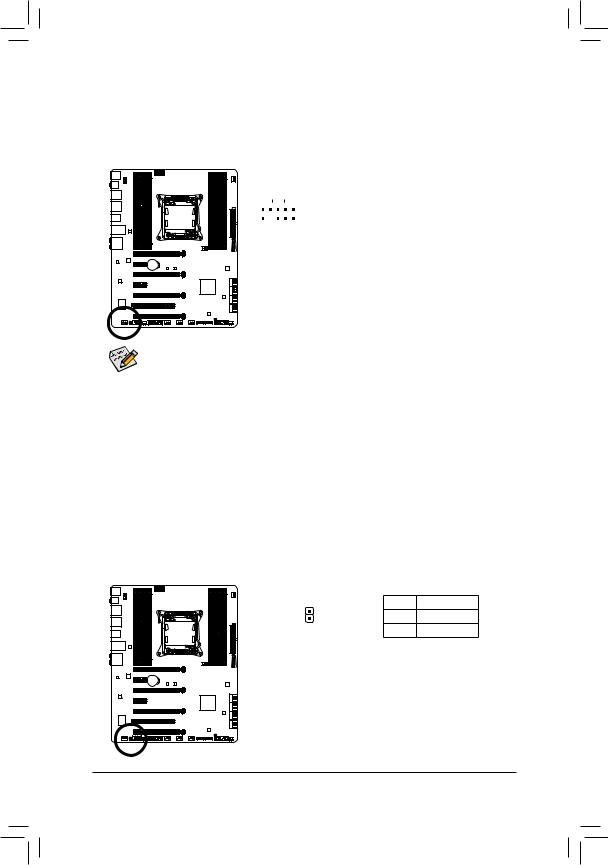
11)F_AUDIO (Front Panel Audio Header)
The front panel audio header supports Intel High Definition audio (HD) andAC'97 audio. You may connect your chassis front panel audio module to this header. Make sure the wire assignments of the module connector match the pin assignments of the motherboard header. Incorrect connection between the module connector and the motherboard header will make the device unable to work or even damage it.
|
|
|
|
For HD Front Panel Audio: |
For AC'97 Front Panel Audio: |
|||
9 |
1 |
|
Pin No. |
Definition |
|
Pin No. |
Definition |
|
|
1 |
MIC2_L |
|
1 |
MIC |
|||
|
|
|
|
2 |
GND |
|
2 |
GND |
|
|
|
|
3 |
MIC2_R |
|
3 |
MIC Power |
|
|
|
|
|
||||
10 |
2 |
|
|
|||||
|
4 |
-ACZ_DET |
|
4 |
NC |
|||
|
|
|
|
|
||||
|
|
|
|
5 |
LINE2_R |
|
5 |
Line Out (R) |
|
|
|
|
6 |
GND |
|
6 |
NC |
|
|
|
|
7 |
FAUDIO_JD |
|
7 |
NC |
|
|
|
|
8 |
No Pin |
|
8 |
No Pin |
|
|
|
|
9 |
LINE2_L |
|
9 |
Line Out (L) |
|
|
|
|
10 |
GND |
|
10 |
NC |
•• The front panel audio header supports HD audio by default. If your chassis provides an AC'97 front panel audio module, refer to the instructions on how to activate AC'97 functionality via the audio software in Chapter 5, "Configuring 2/4/5.1/7.1-Channel Audio."
•• Audio signals will be present on both of the front and back panel audio connections simultaneously. If you want to mute the back panel audio (only supported when using an HD front panel audio module), refer to Chapter 5, "Configuring 2/4/5.1/7.1-Channel Audio."
•• Some chassis provide a front panel audio module that has separated connectors on each wire instead of a single plug. For information about connecting the front panel audio module that has different wire assignments, please contact the chassis manufacturer.
12)SPDIF_O (S/PDIF Out Header)
This header supports digital S/PDIF Out and connects a S/PDIF digital audio cable (provided by expansion cards) for digital audio output from your motherboard to certain expansion cards like graphics cards and sound cards. For example, some graphics cards may require you to use a S/PDIF digital audio cable for digital audio output from your motherboard to your graphics card if you wish to connect an HDMI display to the graphics card and have digital audio output from the HDMI display at the same time.
For information about connecting the S/PDIF digital audio cable, carefully read the manual for your expansion card.
|
Pin No. |
Definition |
|
1 |
SPDIFO |
1 |
2 |
GND |
Hardware Installation |
- 28 - |
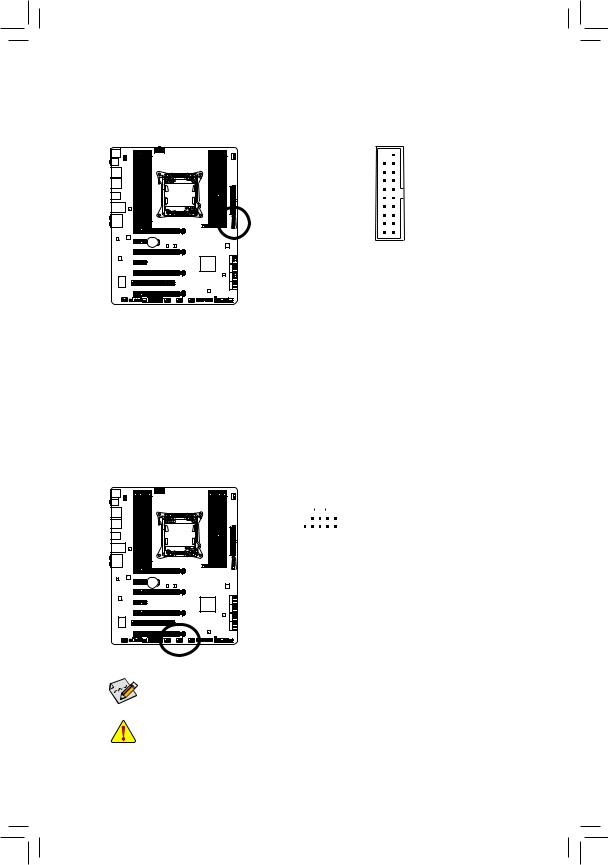
13)F_USB30 (USB 3.0/2.0 Header)
The header conforms to USB 3.0/2.0 specification and can provide two USB ports. For purchasing the optional 3.5" front panel that provides two USB 3.0/2.0 ports, please contact the local dealer.
20 1
|
11 |
10 |
|
|
|
|
|
Pin No. |
Definition |
Pin No. |
Definition |
1 |
VBUS |
11 |
D2+ |
2 |
SSRX1- |
12 |
D2- |
3 |
SSRX1+ |
13 |
GND |
4 |
GND |
14 |
SSTX2+ |
5 |
SSTX1- |
15 |
SSTX2- |
6 |
SSTX1+ |
16 |
GND |
7 |
GND |
17 |
SSRX2+ |
8 |
D1- |
18 |
SSRX2- |
9 |
D1+ |
19 |
VBUS |
10 |
NC |
20 |
No Pin |
14)F_USB1/F_USB2/F_USB3 (USB 2.0/1.1 Headers)
The headers conform to USB 2.0/1.1 specification. Each USB header can provide two USB ports via an optional USB bracket. For purchasing the optional USB bracket, please contact the local dealer.
|
|
|
|
|
Pin No. |
Definition |
9 |
|
|
|
1 |
1 |
Power (5V) |
|
|
|
||||
|
|
|
2 |
Power (5V) |
||
10 |
|
|
|
2 |
||
|
|
|
|
|
3 |
USB DX- |
|
|
|
|
|
||
|
|
|
|
|
||
|
|
|
|
|
4 |
USB DY- |
|
|
|
|
|
5 |
USB DX+ |
|
|
|
|
|
6 |
USB DY+ |
|
|
|
|
|
7 |
GND |
|
|
|
|
|
8 |
GND |
|
|
|
|
|
9 |
No Pin |
|
|
|
|
|
10 |
NC |

 When the system is in S4/S5 mode, only the USB ports routed to the F_USB1 header can support
When the system is in S4/S5 mode, only the USB ports routed to the F_USB1 header can support  the ON/OFF Charge function.
the ON/OFF Charge function.
•• |
Do not plug the IEEE 1394 bracket (2x5-pin) cable into the USB 2.0/1.1 header. |
||
•• |
Prior to installing the USB bracket, be sure to turn off your computer and unplug the power cord |
||
|
from the power outlet to prevent damage to the USB bracket. |
|
|
|
|
|
|
|
- 29 - |
Hardware Installation |
|
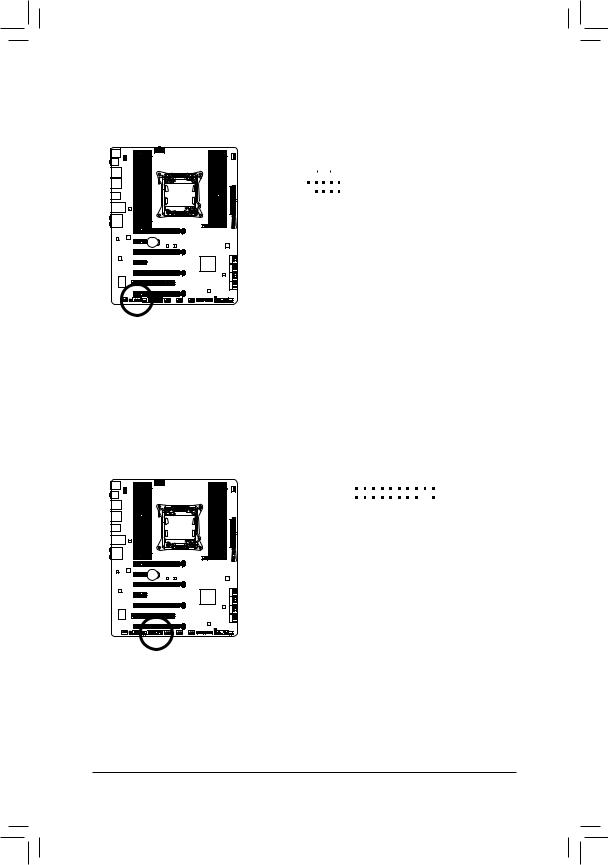
15)COMA (Serial Port Header)
The COM header can provide one serial port via an optional COM port cable. For purchasing the optional COM port cable, please contact the local dealer.
|
|
|
|
|
Pin No. |
Definition |
9 |
|
|
|
1 |
1 |
NDCD- |
|
|
|
2 |
NSIN |
||
10 |
|
|
|
2 |
|
|
|
|
|
3 |
NSOUT |
||
|
|
|
|
|
||
|
|
|
|
|
|
|
|
|
|
|
|
4 |
NDTR- |
|
|
|
|
|
5 |
GND |
|
|
|
|
|
6 |
NDSR- |
|
|
|
|
|
7 |
NRTS- |
|
|
|
|
|
8 |
NCTS- |
|
|
|
|
|
9 |
NRI- |
|
|
|
|
|
10 |
No Pin |
16)TPM (Trusted Platform Module Header)
You may connect a TPM (Trusted Platform Module) to this header.
|
19 |
|
1 |
|
||
|
|
|
|
|
|
|
|
|
|
|
|
|
|
|
20 |
|
2 |
|
||
|
|
|
|
|
|
|
Pin No. |
Definition |
Pin No. |
|
|
Definition |
|
1 |
LCLK |
11 |
|
|
LAD0 |
|
2 |
GND |
12 |
|
|
GND |
|
3 |
LFRAME |
13 |
|
|
NC |
|
4 |
No Pin |
14 |
|
|
ID |
|
5 |
LRESET |
15 |
|
|
SB3V |
|
6 |
NC |
16 |
|
|
SERIRQ |
|
7 |
LAD3 |
17 |
|
|
GND |
|
8 |
LAD2 |
18 |
|
|
NC |
|
9 |
VCC3 |
19 |
|
|
NC |
|
10 |
LAD1 |
20 |
|
|
SUSCLK |
|
Hardware Installation |
- 30 - |
